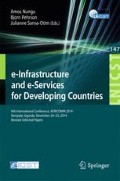Abstract
The performance of a fingerprint authentication system in electronic business depends on the accurate analysis of the quality of input fingerprints. This paper investigates distorted and misaligned fingerprints caused by environmental noise such as oil, wrinkles, dry skin, dirt and displacement of the query fingerprint with the database fingerprint template during matching. The noisy, distorted and/or misaligned fingerprint produced as a 2-D on x-y image, is enhanced and optimized using a new hybrid modified Gabor filter-hierarchal structure check (MGF-HSC) system model based on an MGF integrated with a HSC. Our findings indicate that structural matching is experimentally confirmed as a reliable matching technique in a fingerprint authentication system, as distorted fingerprints can easily be matched, even when the pixel value detected is low, while the rotational and geometrical transformation that affects fingerprint authentication is addressed. The MGF-HSC approach minimizes false fingerprint matching and the dominant effect of distortion and misalignment of fingerprints to an acceptable level. Our approach, which is benchmarked with publicly available methods, deals with 60 % heavy distortions and misaligned fingerprint and exhibits reliable matching performance for promising e-business security work in terms of visual quality, false rejection rate and false acceptance rate.
Access this chapter
Tax calculation will be finalised at checkout
Purchases are for personal use only
References
Senior, A., Bole, R.: Improved fingerprint matching by distortion removal. IEICE trans. Inf. Sys. E84-D, 825–831 (2001)
Esan, O.A., Ngwira, S.M., Osunmakinde, I.O.: Bimodal biometrics for financial infrastructure security. In: Information Security for South Africa (ISSA), South Africa (2013)
Bazen, A.M., Verwaaijen, G.T.B., Gerez, S.H., Veelenturf, L.P.J., van der Zwaag, B.J.: A correlation-based fingerprint verification system. In: proRISC 2000 Workshop on Circuits, System and Sigbal Processing (2000)
Team, V.B.R., Service U.S.S.: A Study of Data Breach Investigation Record in Financial Institutions (2010)
El-Sisi, A.: Design and implementation biometric access control system using fingerprint for restricted area based on Gabor filter. Int. Arab J. Inf. Technol. 8(4), 355--363 (2011)
Jiang, X., Yau, W.Y.: Fingerprint matching based on local and global structure. In: Proceedings of the 15th International Conference on Pattern Recognition, Barcelona, IEEE (2000)
Fons, M., Fons, F., Canto, E.: Design of an embedded Fingerprint Matcher System (2006)
Gebroyohanne, T., Kim, D.Y.: Adaptive Noise Reduction Scheme for Salt and Pepper, Computer Engineering, Ajou University, Suwon, South Korea (2008)
Hong, L., Wan, Y., Jain, A.: Fingerprint image enhancement: algorithm and performance evaluation. IEEE Trans. Pattern Anal. Mach. Intell. 20, 777–789 (1998)
Yang, J., et al.: Modified Gabor filter designed method for fingerprint image enchacement. Pattern Recogn. Lett. 24(12), 1805--1817 (2003). Elsevier
Uludag, U., Pankanti, S., Jain, A.K.: Fuzzy vault for fingerprints. In: Kanade, T., Jain, A., Ratha, N.K. (eds.) AVBPA 2005. LNCS, vol. 3546, pp. 310–319. Springer, Heidelberg (2005)
Xi, K., Hu, J.: Biometric Mobile Template Protection: A Composite Feature -based Fingerprint Fuzzy Vault, School of Computer Science and IT, RMIT University (2003)
Awad, A.S., Man, H.: Similar neighbour criterion for impulse noise removal in images. Int. J. Electron. Commun. 64, 904–915 (2010)
Ko, T.: Multimodal biometric identification for large user population using fingerprint, face and iris recognition. In: Proceedings of the 34th Applied Imagery and Pattern Recognition Workshop (AIPR 2005), pp. 144–152 (2005)
El-Iskandarani, M.A., Abdul-Kader, H.M.: Biometric authentication system Using fingerprints based on Self-Organizing Map Neural Network Classifier. Alexandra Engineering Journal 44, 731–743 (2005)
Acknowledgments
The authors acknowledges the financial support of Tshwane University of Technology and resources made available by University of South Africa.
Author information
Authors and Affiliations
Corresponding author
Editor information
Editors and Affiliations
ANNEXURE
ANNEXURE
Thus, parameter translation (PR) in Eq. (1),
For \( x \)-component in Eq. (2),
and for \( y \)-component in Eq. (3),
For parameter distance in Eq. (4) \( \left( {x,y} \right) \),
The second distance is in (5), for \( x \)-component in Eq. (5),
Thus, parameter translation (PT) in Eq. (6),
For the\( y \)-component in Eq. (7),
For the \( \phi \)-component in Eq. (8)
Condition 1: Matching with a predefined threshold value as in Eq. (9),
Condition 2: Matching with a specified tolerance value as in Eq. (10),
where \( G \) the number of valid users fingerprint who are incorrectly denied access and \( N \) is total number of genuine fingerprint tested.
where \( I \) the number of imposters’ fingerprints is incorrectly granted and \( N \) is the total number of genuine fingerprint tested.
where \( SA \) is the system accuracy, \( M \) is the total number of organized fingerprint image samples and \( P \) is the total number of fingerprint samples.
\( D_{1} \) is adopted as the maximum depth difference between the similar \( x \) and \( y \) pixels and is often assumed to be eight pixels in the neighborhood. \( N_{1}^{th} \) is one, as every pixel is assumed to be similar to at least one pixel, and K is the number of \( y \) pixels that satisfies Eq. (14) while the distorted pixel is eliminated.
Rights and permissions
Copyright information
© 2015 Institute for Computer Sciences, Social Informatics and Telecommunications Engineering
About this paper
Cite this paper
Esan, O.A., Osunmakinde, I.O., Ngwira, S.M. (2015). Performance Evaluation of Fingerprint Biometrics Systems for e-Business Access Control. In: Nungu, A., Pehrson, B., Sansa-Otim, J. (eds) e-Infrastructure and e-Services for Developing Countries. AFRICOMM 2014. Lecture Notes of the Institute for Computer Sciences, Social Informatics and Telecommunications Engineering, vol 147. Springer, Cham. https://doi.org/10.1007/978-3-319-16886-9_28
Download citation
DOI: https://doi.org/10.1007/978-3-319-16886-9_28
Published:
Publisher Name: Springer, Cham
Print ISBN: 978-3-319-16885-2
Online ISBN: 978-3-319-16886-9
eBook Packages: Computer ScienceComputer Science (R0)

